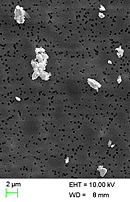Car brakes just as big an environmental problem as studded tyres
You have just removed your winter studded tyres. It is too early for you to breathe out, that is if you live in an urban environment. Research at KTH is able to show that the particles a vehicle's brakes produce are so small that there is a risk that they can cause the same respiratory diseases as studded tyres. In addition, your car brakes contribute just as many particles as studded tyres and the car’s exhaust gas emissions do.

"We have looked at emissions from cars, how they are produced, the substances we are concerned about and how large the particles are. Through tests we have found out that the particles from a car's brakes are less than 10 µm in size and even go down to nano sizes, which means that they can enter the human body when we breathe, says Ulf Olofsson, professor and head of the Department of Machine Design at KTH.
What is relevant is that particles less than 10 µm in size remain floating around for several hours. Particles which are very close to nano size are so light that they can remain floating around for several weeks.
When these particles find their way into your lungs they remain there and can create inflammations and other respiratory diseases, they can also cause cardiovascular diseases and cancer. This has been demonstrated in several studies from, among others, the World Health Organisation.
Car brakes including the discs and brake linings are a little like a black chemical box, says Ulf Olofsson. This is where you will find everything from metals such as copper and iron oxide to ground-down cashew nut shells.
"For example, iron oxide is dangerous to breathe in," says Ulf Olofsson.
A reduction of the particles could be made by using less aggressive brake linings as they do with American brakes. According to Ulf Olofsson, 30% less emissions is realistic. But then, the brakes would not be as effective.
"Having said that, European brakes are adapted to the high speeds permitted on the German autobahn, and we do not permit such speeds here in Sweden. So American brakes are probably quite adequate. The industry is very much affected by the tests carried out by magazines such as Auto Motor & Sport. And nobody wants to get poor results there. So none of these suppliers would ever dare put on other, less aggressive brakes," says Ulf Olofsson.
Most of the particles are generated when you brake, but particles are generated even when you are not using the brakes.
"Brake linings rest against the discs all the time in order to remove rust and keep the discs clean," says Ulf Olofsson.
Tests have been carried out both in laboratory environments and on cars, and the next step according to Jens Wahlström, a doctoral student at KTH who has conducted the research work, is to research further. To develop models and equipment so that we can predict the emissions and further develop vehicle braking systems.
"Most modern vehicles have disc brakes on the front wheels which are not isolated from the surrounding air. The air helps to cool down the disc brakes, but the particles produced can easily spread out into the air. New environmentally adapted disc brakes may improve the urban environment, says Jens Wahlström.
For more information, contact Ulf Olofsson at 08 - 790 63 04 / ulfo@md.kth.se or Jens Wahlström at 08 - 790 78 60 / jensw@md.kth.se.
Peter Larsson

